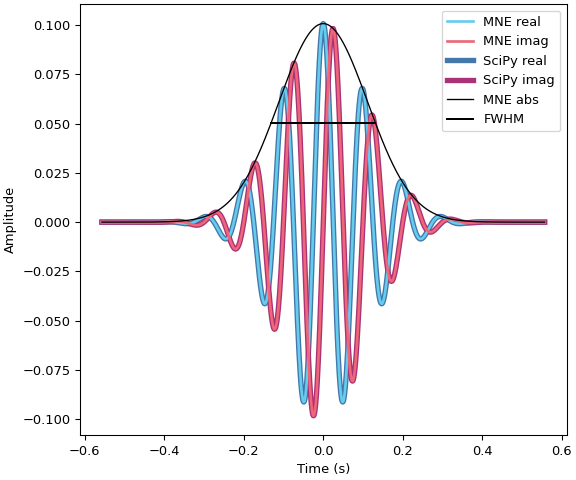mne.time_frequency.tfr.morlet#
- mne.time_frequency.tfr.morlet(sfreq, freqs, n_cycles=7.0, sigma=None, zero_mean=False)[source]#
Compute Morlet wavelets for the given frequency range.
- Parameters
- sfreq
float The sampling Frequency.
- freqs
float| array_like, shape (n_freqs,) Frequencies to compute Morlet wavelets for.
- n_cycles
float| array_like, shape (n_freqs,) Number of cycles. Can be a fixed number (float) or one per frequency (array-like).
- sigma
float, defaultNone It controls the width of the wavelet ie its temporal resolution. If sigma is None the temporal resolution is adapted with the frequency like for all wavelet transform. The higher the frequency the shorter is the wavelet. If sigma is fixed the temporal resolution is fixed like for the short time Fourier transform and the number of oscillations increases with the frequency.
- zero_mean
bool, defaultFalse Make sure the wavelet has a mean of zero.
- sfreq
- Returns
See also
Notes
The Morlet wavelets follow the formulation in 1.
Convolution of a signal with a Morlet wavelet will impose temporal smoothing that is determined by the duration of the wavelet. In MNE-Python, the duration of the wavelet is determined by the
sigmaparameter, which gives the standard deviation of the wavelet’s Gaussian envelope (our wavelets extend to ±5 standard deviations to ensure values very close to zero at the endpoints). Some authors (e.g., 2) recommend specifying and reporting wavelet duration in terms of the full-width half-maximum (FWHM) of the wavelet’s Gaussian envelope. The FWHM is related tosigmaby the following identity: \(\mathrm{FWHM} = \sigma \times 2 \sqrt{2 \ln{2}}\) (or the equivalent in Python code:fwhm = sigma * 2 * np.sqrt(2 * np.log(2))). Ifsigmais not provided, it is computed fromn_cyclesas \(\frac{\mathtt{n\_cycles}}{2 \pi f}\) where \(f\) is the frequency of the wavelet oscillation (given byfreqs). Thus whensigma=Nonethe FWHM will be given by\[\mathrm{FWHM} = \frac{\mathtt{n\_cycles} \times \sqrt{2 \ln{2}}}{\pi \times f}\](cf. eq. 4 in 2). To create wavelets with a chosen FWHM, one can compute:
n_cycles = desired_fwhm * np.pi * np.array(freqs) / np.sqrt(2 * np.log(2))
to get an array of values for
n_cyclesthat yield the desired FWHM at each frequency infreqs. If you want different FWHM values at each frequency, do the same computation withdesired_fwhmas an array of the same shape asfreqs.References
- 1
Catherine Tallon-Baudry, Olivier Bertrand, Claude Delpuech, and Jacques Pernier. Oscillatory Gamma-Band (30–70 Hz) Activity Induced by a Visual Search Task in Humans. Journal of Neuroscience, pages 722–734, 1997. doi:10.1523/JNEUROSCI.17-02-00722.1997.
- 2(1,2)
Michael X Cohen. A better way to define and describe Morlet wavelets for time-frequency analysis. NeuroImage, 199:81–86, 2019. doi:10.1016/j.neuroimage.2019.05.048.
Examples
Let’s show a simple example of the relationship between
n_cyclesand the FWHM usingmne.time_frequency.fwhm(), as well as the equivalent call usingscipy.signal.morlet2():import numpy as np from scipy.signal import morlet2 as sp_morlet import matplotlib.pyplot as plt from mne.time_frequency import morlet, fwhm sfreq, freq, n_cycles = 1000., 10, 7 # i.e., 700 ms this_fwhm = fwhm(freq, n_cycles) wavelet = morlet(sfreq=sfreq, freqs=freq, n_cycles=n_cycles) M, w = len(wavelet), n_cycles # convert to SciPy convention s = w * sfreq / (2 * freq * np.pi) # from SciPy docs wavelet_sp = sp_morlet(M, s, w) * np.sqrt(2) # match our normalization _, ax = plt.subplots(constrained_layout=True) colors = { ('MNE', 'real'): '#66CCEE', ('SciPy', 'real'): '#4477AA', ('MNE', 'imag'): '#EE6677', ('SciPy', 'imag'): '#AA3377', } lw = dict(MNE=2, SciPy=4) zorder = dict(MNE=5, SciPy=4) t = np.arange(-M // 2 + 1, M // 2 + 1) / sfreq for name, w in (('MNE', wavelet), ('SciPy', wavelet_sp)): for kind in ('real', 'imag'): ax.plot(t, getattr(w, kind), label=f'{name} {kind}', lw=lw[name], color=colors[(name, kind)], zorder=zorder[name]) ax.plot(t, np.abs(wavelet), label=f'MNE abs', color='k', lw=1., zorder=6) half_max = np.max(np.abs(wavelet)) / 2. ax.plot([-this_fwhm / 2., this_fwhm / 2.], [half_max, half_max], color='k', linestyle='-', label='FWHM', zorder=6) ax.legend(loc='upper right') ax.set(xlabel='Time (s)', ylabel='Amplitude')
